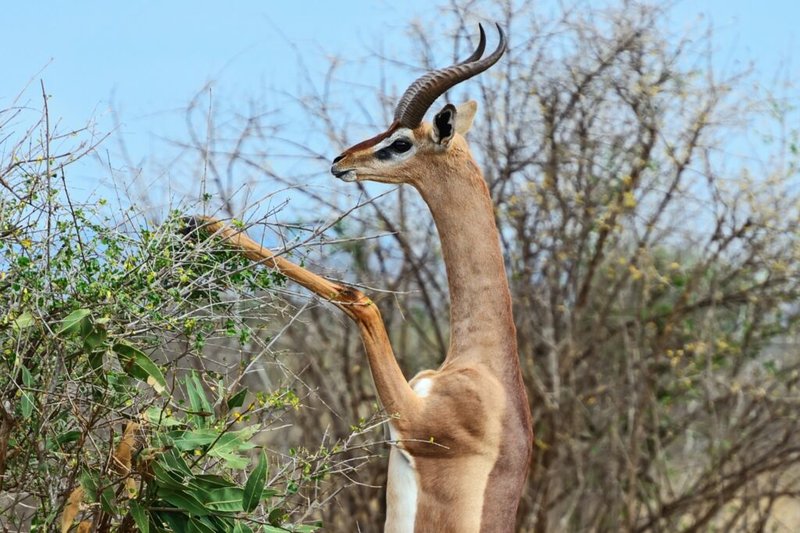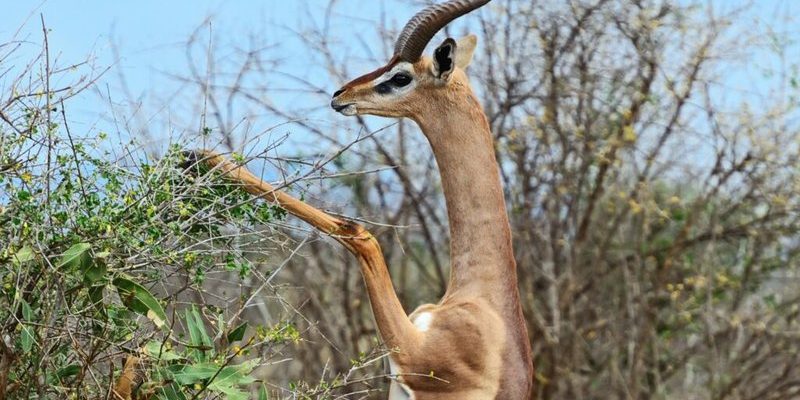
Have you ever heard of a gerenuk? This fascinating creature, often referred to as the “giraffe-necked” antelope, is a sight to behold in the wild. With its slender frame and strikingly elongated neck, the gerenuk stands out in the African savannah. Imagine a graceful ballerina, poised and elegant, effortlessly grazing on the tallest leaves that other antelopes can’t reach. That’s the gerenuk for you!
Natively found in the dry regions of East Africa, particularly in countries like Kenya and Somalia, these unique animals have adapted remarkably to their environment. Their ability to stand on their hind legs to nibble on treetops sets them apart in the antelope family. As we dive deeper into understanding the gerenuk, you’ll discover why they are not just interesting but also crucial to their ecosystem.
Physical Characteristics of the Gerenuk
The gerenuk is truly a remarkable antelope. It typically reaches a height of about 3 to 4.5 feet at the shoulder, with males being slightly larger than females. Their long necks can reach out like a graceful arm, allowing them to feed on high vegetation. This ability comes in handy during dry seasons when food is scarce.
Besides their necks, gerenuks have a beautiful golden-brown coat that provides excellent camouflage amidst the scrub and bushes of their habitat. They have large, expressive eyes, which help them spot potential predators from a distance. Their long legs not only aid in reaching high branches but also enable quick escapes when danger lurks nearby.
Another unique aspect of the gerenuk’s appearance is their horns. Males feature twisted, spiraled horns that can grow up to 30 inches long. These horns are not just for show; they play a significant role in male competitions, particularly during mating season.
Habitat and Distribution
The natural habitat of the gerenuk is primarily arid and semi-arid regions of East Africa. They prefer open savannahs, scrublands, and bushlands, where they can easily find food while maintaining a watchful eye for predators. The gerenuk’s ability to thrive in these conditions is a testament to its remarkable adaptability.
In terms of distribution, you’ll find gerenuks mainly in Kenya, Somalia, and parts of Tanzania. They are specially adapted to endure long periods without drinking water. Instead, they derive moisture from the plants they consume. This ability makes them perfectly suited for their dry, harsh environments, where water sources can be few and far between.
If you ever find yourself exploring the wonders of East Africa, keep your eyes peeled for these elegant creatures. You’ll often spot them near acacia trees, stretching their necks to reach the tender leaves. Just picture a serene landscape with these graceful antelopes effortlessly reaching for the sky. It’s a truly magical sight!
Diet and Feeding Habits
The gerenuk is an herbivore, with a diet predominantly consisting of leaves, flowers, and fruits. They are particularly fond of acacia, bush mallow, and various other shrubs found in their habitat. Their long necks are a functional marvel, enabling them to browse on foliage that is often out of reach for other herbivores.
Interestingly, gerenuks are mainly crepuscular, meaning they are most active during dawn and dusk. This behavior helps them avoid the heat of the day and reduces competition for food. During these cooler hours, you might see them standing on their hind legs to reach higher branches, almost as if they’re trying to give you a closer look at how fascinating their feeding style is.
What’s more, gerenuks are known for their unique habit of remaining alert and vigilant while feeding. They often maintain a keen sense of awareness, constantly scanning their surroundings for threats. This level of vigilance is crucial, as they have a natural predator in lions, hyenas, and leopards. It’s fascinating how their feeding strategies are intertwined with their survival tactics!
Behavior and Social Structure
Gerenuks are generally solitary animals, although they can sometimes be seen in small groups, especially females with their young. Males are often more territorial and may establish dominance through displays of strength, such as horn clashing. This behavior is essential during mating season, where competition for females can be fierce.
When it comes to communication, gerenuks have a range of vocalizations, from snorts to grunts, to alert others of potential dangers. Their keen senses also help them detect predators early, allowing them to flee swiftly if needed. It’s almost like they have a sixth sense for survival!
Interestingly, these animals are also known to exhibit some level of social behavior, particularly when it comes to grooming one another. This practice helps strengthen social bonds within small groups. It’s a reminder that even in the wild, the social dynamics of animals play a vital role in their overall well-being.
Reproduction and Lifespan
The mating season for gerenuks typically falls during the rainy seasons, which is when food is plentiful. Males will engage in dramatic displays to attract females, showcasing their impressive horns and physical prowess. Once a female is receptive, she will mate, and after a gestation period of about 7.5 months, she gives birth to a single calf.
Calves are born with spots, which help them blend into their surroundings and avoid detection by predators. This natural camouflage is crucial for their survival in their early days. Mothers often hide their young in thick vegetation while they feed nearby, returning frequently to nurse them. It’s heartwarming to think of that bond between a mother and her calf in the wild!
In terms of lifespan, gerenuks typically live around 10 to 12 years in the wild. In captivity, where they face fewer threats, they can live even longer, sometimes reaching up to 15 years. This longevity showcases the importance of protecting their natural habitats to ensure a future for these stunning creatures.
Conservation Status
Currently, the gerenuk is classified as “Least Concern” by the IUCN, meaning they are not immediately at risk of extinction. However, they do face threats, primarily from habitat loss due to human activities such as agriculture and urban development. The encroachment of livestock also poses a challenge, as it can lead to competition for food sources.
Conservation efforts are essential to maintain healthy populations of gerenuks in the wild. Protecting their habitats and promoting sustainable land-use practices can help ensure these unique animals continue to thrive. Additionally, raising awareness about their role in the ecosystem can motivate local communities to appreciate and conserve these fascinating creatures.
One key to their future lies in community-based conservation programs. Engaging local populations in conservation efforts not only protects the gerenuks but also supports the biodiversity of the entire region. It’s a win-win situation for both the wildlife and the communities that share their landscape.
Interesting Facts
- The name “gerenuk” means “graceful” in the Somali language.
- Gerenuks can stand on their hind legs for long periods while feeding, which is quite unique among antelopes.
- They have excellent eyesight and hearing, making them vigilant against predators.
- Gerenuks are part of the Bovidae family, which also includes animals like cows and goats.
- These animals are known to be able to go without water for long stretches, relying on moisture from the plants they eat.
FAQ
What is a gerenuk’s primary diet?
The gerenuk primarily feeds on leaves, flowers, and fruits. They are known to favor acacia trees and other shrubs, using their long necks to reach high branches that other antelopes cannot. This feeding strategy is particularly beneficial during the dry season when food is scarce.
How do gerenuks communicate?
Gerenuks communicate using a variety of vocalizations, including snorts and grunts. These sounds can convey information about danger or territorial disputes. Additionally, their keen senses help them detect predators, allowing for a quick response to potential threats.
Are gerenuks social animals?
While gerenuks are generally solitary, they can sometimes be found in small groups, especially females with their calves. Males are usually more territorial and may display strength through horn clashing, particularly during mating season. Social grooming behaviors can also occur among small groups, strengthening bonds.
Where can you find gerenuks in the wild?
Gerenuks are primarily found in the dry regions of East Africa, particularly in countries like Kenya, Somalia, and parts of Tanzania. They prefer open savannahs and scrublands where they can find food and watch for predators.
What threats do gerenuks face?
Gerenuks face several threats, primarily habitat loss due to human activities such as agriculture and urban development. Competition with livestock for food sources can also pose a significant challenge to their survival.
How long do gerenuks typically live?
In the wild, gerenuks typically live around 10 to 12 years. However, in captivity, where they face fewer dangers, they can live up to 15 years. Their lifespan emphasizes the importance of conserving their natural habitats.
What is unique about a gerenuk’s neck?
The gerenuk’s neck is extraordinarily long compared to other antelope species, allowing them to reach high branches to feed on leaves and flowers. This adaptation gives them a competitive edge in their habitat, especially during dry seasons when food is limited.
Are gerenuks endangered?
Currently, gerenuks are classified as “Least Concern” by the IUCN. However, they do face threats mainly due to habitat loss and competition with livestock. Conservation efforts are essential for maintaining their populations and ensuring their long-term survival.
How do gerenuks care for their young?
After a gestation period of about 7.5 months, a female gerenuk typically gives birth to a single calf. The mother hides her young in thick vegetation to protect them from predators while she feeds. This nurturing behavior is vital for calf survival in their natural habitat.
What adaptations help gerenuks survive in their habitat?
Gerenuks are equipped with several adaptations for survival, such as their long necks for browsing on high vegetation, excellent eyesight for spotting predators, and the ability to go without water for extended periods. These traits help them thrive in the arid conditions of their environment.
Do gerenuks have any natural predators?
Yes, gerenuks have several natural predators, including lions, leopards, and hyenas. Their keen senses and ability to detect danger early play a critical role in their survival, allowing them to escape when threats arise.
Can gerenuks be found in zoos?
Yes, gerenuks are often kept in zoos, primarily for conservation and educational purposes. These settings allow for public awareness about the species and help promote conservation efforts in the wild.
Why is it important to conserve gerenuks?
Conserving gerenuks is vital not only for maintaining the species but also for preserving the biodiversity of the ecosystems they inhabit. They play an important role in their habitats, and protecting them can benefit both wildlife and local communities.
What role do communities play in gerenuk conservation?
Community involvement is crucial in conservation efforts for gerenuks. Engaging local populations in protecting habitats and promoting sustainable land-use practices can lead to positive outcomes for wildlife and enhance the local economy.

